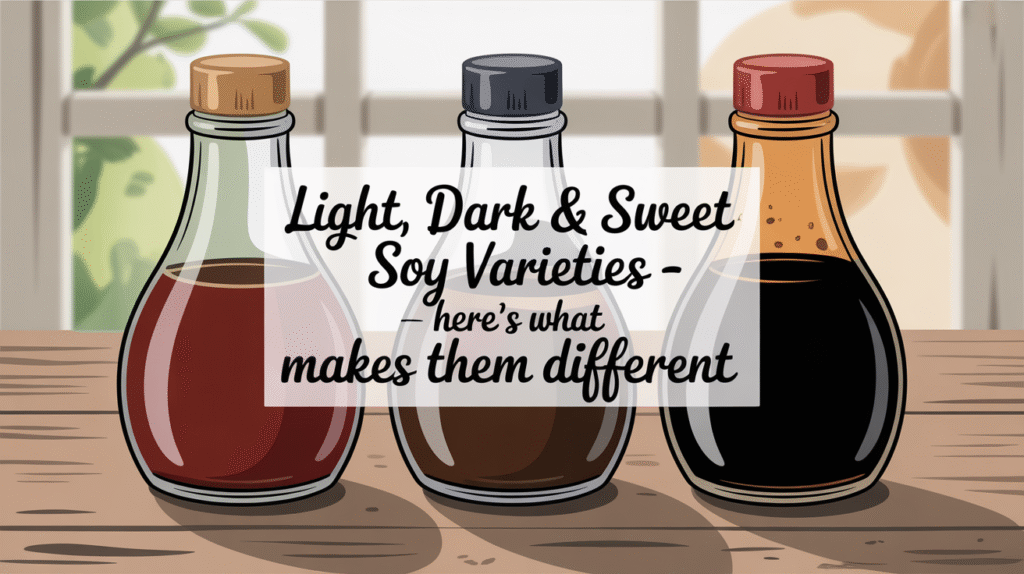Affiliate Disclosure: PantryBrands.co.uk is a participant in the Amazon.co.uk Associates Programme. As an Amazon Associate, we earn from qualifying purchases made through links on this site.
The main difference between light, dark, and sweet soy sauce varieties lies in their flavour, colour, thickness, and intended use in cooking. Light soy sauce is salty and thin, dark soy sauce is thicker and richer with a hint of sweetness, and sweet soy sauce is syrupy and primarily used for adding sweetness and shine to dishes.

In this article, we’ll break down the key differences between the main soy sauce varieties, when to use each, and how they impact your recipes – especially if you’re cooking traditional Asian meals or adapting them to modern British kitchens.
Why Soy Sauce Varieties Matter in Cooking
Choosing the right type of soy sauce affects the taste, colour, and overall balance of a dish. While all soy sauces deliver that essential umami depth, not all of them are interchangeable.
Differences Go Beyond Just Colour
These varieties are made using different brewing methods and ingredients, each offering distinct roles in cooking:
- Light soy sauce brings saltiness and is often used for seasoning.
- Dark soy sauce adds colour and depth to cooked dishes.
- Sweet soy sauce balances savoury dishes with a rich, molasses-like sweetness.
Understanding their differences helps avoid common cooking mistakes, like making a dish too salty or sweet by using the wrong variety.
What Is Light Soy Sauce?
Light soy sauce, also known as “regular” or “thin” soy sauce, is the most commonly used variety in both Chinese and general Asian cooking.
Characteristics of Light Soy Sauce
Light soy sauce offers a clean, salty taste that enhances ingredients without overpowering them.
- Pale to medium brown in colour and thin in consistency.
- Primarily used for seasoning rather than colouring.
- Usually the default soy sauce in recipes unless otherwise specified.
When to Use Light Soy Sauce
This variety is best when you want flavour without darkening the dish.
- Stir-fries and quick-cooked vegetables.
- Dipping sauces for dumplings or spring rolls.
- Marinades for meats and tofu.
What Is Dark Soy Sauce?
Dark soy sauce is thicker, less salty, and richer in taste due to the longer ageing process and added sweeteners like molasses or sugar.
Characteristics of Dark Soy Sauce
This sauce contributes both flavour and a deep, appetising colour to food.
- Dark reddish-brown with a thicker, syrupy consistency.
- Milder in saltiness but stronger in flavour.
- Adds depth and glaze to dishes.
When to Use Dark Soy Sauce
It’s mainly used in slow-cooked or braised dishes where colour and flavour richness are needed.
- Braised meats and stews.
- Fried rice and noodle dishes.
- As a base for Chinese sauces and gravies.
What Is Sweet Soy Sauce?
Sweet soy sauce, often called kecap manis in Indonesian cuisine, is a thick, syrup-like sauce made with generous amounts of sugar or palm sugar.
Characteristics of Sweet Soy Sauce
Its primary role is to sweeten and glaze, often balancing out salty or spicy dishes.
- Very thick and sticky with a molasses-like consistency.
- Strongly sweet with mild saltiness.
- Sometimes includes spices like star anise or cloves.
When to Use Sweet Soy Sauce
Ideal for recipes that benefit from a balance of sweet and savoury.
- Drizzled over grilled meats or satays.
- Added to fried rice or stir-fried vegetables for a glossy finish.
- As a dipping sauce for egg rolls and fritters.
Comparing Light, Dark and Sweet Soy Sauce
Each soy sauce variety serves a distinct purpose. Here’s how they compare at a glance.
Flavour Profile
- Light Soy Sauce: Salty and sharp.
- Dark Soy Sauce: Rich, slightly sweet, less salty.
- Sweet Soy Sauce: Very sweet, mild saltiness.
Colour and Texture
- Light: Light brown, watery.
- Dark: Deep brown, thick.
- Sweet: Black, syrup-like.
Common Uses
- Light: Dips, seasoning, quick stir-fries.
- Dark: Braising, colour enhancement, rich sauces.
- Sweet: Indonesian dishes, glazing, balanced sweetness.
Tips for Using Each Soy Sauce Correctly
Using the right soy sauce at the right time will help elevate your cooking without overwhelming it.
Cooking Advice
Here are some quick tips to remember when cooking with soy sauce varieties:
- Don’t substitute dark soy for light soy – your dish may end up too sweet or too dark.
- Mix varieties for complex flavour. For example, combine light and dark soy sauces in marinades.
- Taste as you go, especially with sweet soy sauces which can quickly dominate a dish.
Popular Brands Offering Each Variety in the UK
If you’re shopping in Britain, here are some widely available options.
Light Soy Sauce Brands
- Kikkoman Naturally Brewed Soy Sauce
- Blue Dragon Light Soy Sauce
- Amoy Light Soy Sauce
Dark Soy Sauce Brands
- Lee Kum Kee Premium Dark Soy Sauce
- Amoy Dark Soy Sauce
- Pearl River Bridge Superior Dark Soy Sauce
Sweet Soy Sauce Brands
- ABC Kecap Manis (Indonesian)
- Yeo’s Sweet Soy Sauce
- Healthy Boy Sweet Soy Sauce (Thai)
FAQs About Light, Dark & Sweet Soy Varieties
Here are some questions and answers about the differences between soy sauce varieties.
Can I use dark soy sauce instead of light soy sauce?
Not ideally. Dark soy sauce is less salty and much thicker. It’s intended to add colour and depth rather than sharp seasoning, so using it instead of light soy sauce may change the taste and texture of your dish.
Is sweet soy sauce the same as dark soy sauce?
No. While both are dark and thick, sweet soy sauce contains significantly more sugar and has a much sweeter flavour. They are not interchangeable in most recipes.
What’s the best soy sauce to use for stir-fry?
Light soy sauce is the best choice for stir-frying because it seasons food quickly and doesn’t overpower the dish with colour or sweetness. Some recipes may also include a touch of dark soy sauce for richness.
Are all soy sauces gluten-free?
Not all. Many soy sauces (especially light and dark) contain wheat. If you require a gluten-free option, look for certified gluten-free soy sauce or tamari.
Can I mix soy sauce varieties together?
Yes. Many traditional recipes use both light and dark soy sauce for balance — light for saltiness and dark for colour. Just be mindful of the combined sodium and sweetness levels.
